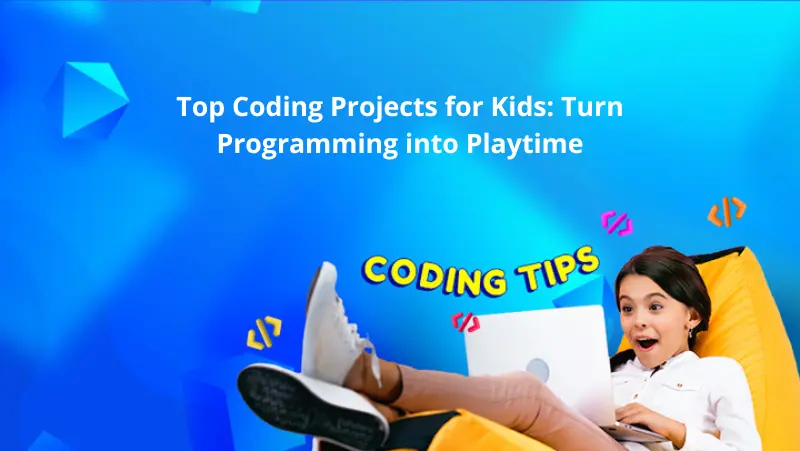Coding is an incredibly valuable skill that can benefit children in many ways. Not only does it teach logic and problem-solving skills, but it also helps to develop creativity and innovation. Plus, coding can be a lot of fun! In this blog, we’ll explore some fun coding projects for kids that will help them learn to code while having a blast. Let’s start our exploration towards coding for a nail-biting experience!
Table of contents
What is Coding?
The term coding was coined by two great scientists in history, Jacquard Looms, and Charles Babbage. The main idea behind the coding is that they wanted to talk to the machine and make the machine work on some of the tasks. That’s the main motto behind the concept of coding; it seems interesting, isn’t it? Yes, it is. Let’s break down some of the interesting features so the kids can perform the coding.
Know more more about coding for kids
Creating a Simple Game
One of the best ways to get kids interested in coding is to have them create their own games. A simple game like a quiz or a guessing game can be a great starting point. Children can use coding languages such as Scratch or Python to create a game with graphics and sound effects.
Scratch is a visual programming language that is designed specifically for kids. It uses drag-and-drop blocks that snap together like puzzle pieces. With Scratch, kids can create interactive stories, games, and animations. Python is a text-based programming language that is widely used in industry. It is a great language for kids to learn because it is simple and easy to read. The students are more interested in the concepts of Scratch because of its UI and block-based approach.

The above image represents the general UI of Scratch.
A link to the scratch website is attached here: Scratch
Usually, developers have communities regardless of their working programming language. Scratch is the first platform to introduce communities for kids if they face any issues with coding.
When creating a game, kids can start by designing the basic game mechanics. This might include defining the rules of the game, designing the levels, and creating the characters. Then, they can start coding the game using the programming language of their choice. With a bit of trial and error, kids can create a game that they can play and share with their friends.
Designing a Website
Designing a website is another fun coding project for kids. Children can learn to code using HTML and CSS to create a website with text, images, and links. This project can be a great opportunity for kids to showcase their creativity while developing their coding skills.
HTML is a markup language that is used to structure web pages. It defines the headings, paragraphs, and other elements of a web page. CSS is a style sheet language that is used to control the appearance of web pages. With HTML and CSS, kids can create a website that is both functional and visually appealing. This HTML not only provides immediate output but also provides the children with a sense of accomplishment as the output is viewed.

Link for learning the HTML: Learn HTML
W3Schools is one of the most famous and commonly used websites for learning HTML. The link for the W3Schools has been attached above.
When designing a website, kids can start by defining the purpose of the website. This might include creating a personal blog, designing a portfolio, or showcasing a hobby. Then, they can start coding the website using HTML and CSS. With a bit of practice, kids can create a website that they can share with their friends and family.

The above image represents the general structure of the HTML language.
Building a Robot
Building a robot is a great coding project for kids who love hands-on projects. Kids can use coding languages like Arduino to program their robot’s movements and actions. This project can help children develop their problem-solving skills as they figure out how to make their robot move and respond to commands.

Everyone loves robots as long as they obey our commands, hahaha! Robotics is one of the technologies with which one can interact with software and hardware.
Arduino is a popular platform for building electronic projects. It is based on a microcontroller that can be programmed using a simplified version of the C programming language. With Arduino, kids can create robots, sensors, and other electronic projects.

The above image is one example of a line-following robot. This follows the line as per the coding written on the Arduino.
When building a robot, kids can start by designing the robot’s mechanical components. This might include designing the chassis, wheels, and motors. Then, they can start coding the robot using Arduino. With a bit of creativity, kids can create a robot that can navigate its environment and perform simple tasks.
Developing an App
With the popularity of mobile devices, developing an app can be a fun and exciting project for kids. Children can use coding languages like Swift or Java to create an app with features like buttons, text fields, and animations. This project can be a great opportunity for kids to learn about user interface design and app development.
These app development technologies also became very feasible, and they came in the form of block-based programming as well. The main platforms that help us do app development using block-based programming are Thunkable and MIT App Inventor. It is similar to that of scratch. In simpler words, it is the advanced version of Scratch.

The above image represents the general landing page UI of Thunkable. We can even publish the apps in the Google Play store and AWS cloud as well.
The next is, Swift is a programming language that is used to develop apps for iOS devices. Java is a programming language that is used to develop apps for Android devices. With these languages, kids can create apps that can be downloaded and used on smartphones and tablets. They can design an app that solves a problem or helps people in their daily lives. Kids can also learn about user interface design and app development. Developing an app can be a great way for kids to showcase their creativity and learn valuable skills that they can use in the future.
Creating an Animated Story
Creating an animated story is a fun coding project for kids that combines art and technology. Using coding languages like Scratch or JavaScript, children can create animations with characters and backgrounds. They can create an animated story about their favorite book, a personal story, or even a fairy tale. Kids can use their imaginations to design characters, backgrounds, and sound effects. Creating an animated story is a great way to teach kids about storytelling, animation, and coding.
For creating these animated stories, we can use the Scratch platform or the Code.org platform. These two platforms are widely used for the same thing. Exploring computer programs for kids can provide them with the skills to create animated stories effectively using platforms like Scratch and Code.org.
Conclusion
Coding can be a fun and rewarding activity for kids of all ages. By introducing children to coding through fun projects like creating a game, designing a website, building a robot, developing an app, or creating an animated story, kids can learn essential coding concepts while having fun. These coding projects can help children develop valuable skills like problem-solving, creativity, and critical thinking. The best thing about these projects is that they can be tailored to a child’s interests, making them more engaging and fun. By encouraging kids to learn to code, we can help them prepare for the future and give them the tools they need to succeed in a rapidly changing world.
Checkout the BrightCHAMPS blog page to learn more about such related topics!
Frequently Asked Questions (FAQs)
There is no starting point, to begin with, as long as the kids are interested. Start with a basic-level programming language, preferably from scratch.
The best age to start coding is the age of 5. If the kid knows how to operate a computer or laptop, then it is more than enough to start the coding journey.
Coding is now widely regarded as one of the essential life skills for children. The early they start, they will explore more concepts and they can adapt to new technologies.













